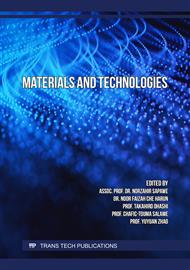p.3
p.13
p.19
p.31
p.37
p.45
p.65
p.73
Performance of Thermally Stable Diamond Composite as Rock Cutting Tips under Varied Resultant Force Angle
Abstract:
Various studies have been carried out to understand the properties and the performance of Thermally Stable Diamond Composite (TSDC) when it is used as the rock cutting tools. Existing studies focused on the influences of uncertain TSDC material properties, and randomly varied rock strengths and thickness on the failure probability of cutting tips made of TSDC. It is found that the compressive strength of TSDC cutting tips is much higher than their tensile strength. As a result, the ability of a TSDC cutting tip to bear the resultant force applied along its axis is much greater than its ability to bear the resultant force perpendicular to its axis. However, the resultant angle during rock cutting processes varies greatly. This study focuses on the investigation of the impact of varied resultant force angles on the performance and failure characteristics of TSDC as a rock cutting tip using Monte Carlo simulations. The results show that the varied resultant angle can significantly influence the failure characteristics of the TSDC cutting tip with a fixed attack angle.
Info:
Periodical:
Pages:
13-18
Citation:
Online since:
December 2022
Authors:
Price:
Сopyright:
© 2022 Trans Tech Publications Ltd. All Rights Reserved
Share:
Citation:



